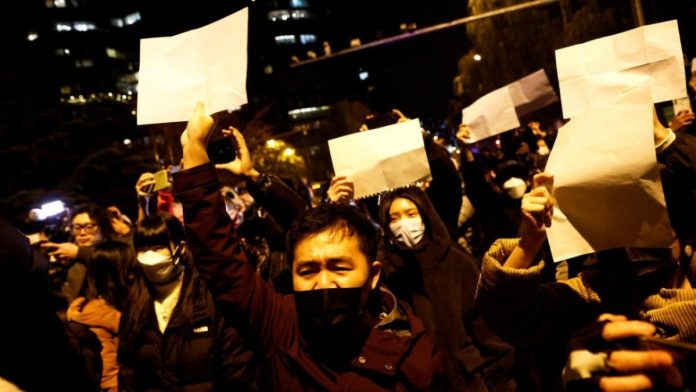“People’s revolution” is a favourite catch phrase of communists and so it’s ironic that a communist regime would try to suppress it, unless you know communism is nothing but dictatorship by a party, sometimes by its honcho. As protests over China’s draconian ‘Zero Covid’ policy flared up in several cities, the Xi Jinping dispensation is planning to censor online content on the rare demonstrations.
For it’s online content that has turned the Communist Party of China (CCP) into an object of criticism across the freedom-loving, democratic world. Frustration at the CCP government’s zero-Covid policy, which sees authorities impose snap lockdowns, lengthy quarantines and mass testing campaigns over just a handful of cases, is fuelling the protests inspired in kind by the pro-democracy uprising in Hong Kong.
Expanse of protests against Xi Jinping
A deadly fire on 24 November in Urumqi, the capital of the Xinjiang province in northwest China, has become a fresh catalyst for public anger, with many blaming Covid lockdowns for hampering rescue efforts. Authorities deny the claims. Hundreds of people massed outside Urumqi’s government offices after the deadly fire, chanting: “Lift lockdowns!” Last night, around 400 people gathered along the banks of a river in the capital Beijing for several hours, with some shouting: “We are all Xinjiang people! Go Chinese people!”
This cannot be dismissed as the anger of Uyghur Muslims just because it’s happening in Xinjiang. In downtown Shanghai, China’s biggest metropolis and industrial hub, police clashed with protesters while trying to move people away from the site. Some of them were seen chanting “Xi Jinping, step down! CCP, step down!”. Three people were arrested from a protest site from the city early this morning.
Protests were staged also in Wuhan, the central Chinese city where Covid-19 first emerged, allegedly when a biological weapon the Xi Jinping regime was building leaked or was deliberately released, while there were reports of demonstrations in Guangzhou, Chengdu and Hong Kong.
In the past week, small — and some large-scale — protests against the Covid policies were seen in Zhengzhou, Urumqi, Haizhu, Xi’an, Nanjing, Beijing, Lanzhou, Changsha, and Korla. The first spark started at the Foxconn factory in Zhengzhou.
The workers at the Foxconn factory in Zhengzhou complained that they were made to share dormitories with other workers who had tested positive for Covid. Apple’s production line has already been suffering due to severe delays owing to labour shortages and Covid protocols.
In the just-concluded weekend, protests raged in over 50 Chinese university campuses, according to a list shared online, and hundreds of people took to the streets in capital Beijing as well. Protestors have simply turned to hold up blank sheets of paper to express anger against Covid-19 restrictions which serves as both a smart and effective way to evade censorship while showing solidarity. The blank white paper was a way of saying a lot by saying nothing at all.
Did you miss this? Chinese people’s protests rage as Bridge Man reminds world of Tank Man
Keywords such as “freedom” and “democracy” have resurfaced in the uprising at the beginning of the third term of Xi Jinping, which the president ensured by kicking out dissenters led by Hu Jintao from the CPC congress. These words in banners and posters were last seen three decades ago during the 1989 student demonstrations in Tiananmen Square. Washington-based sociologist Professor Yang Zhang tweeted: “…full centralized control leads to full responsibility and then national movement targeting at the centre when expectations are not met.”
Protests, repression most violent in Urumqi
On 24 November at 7:49 PM, a fire broke out at a residential building in the Tian Shan district of Urumqi while people were trapped inside the building because of Covid restrictions. They couldn’t escape. As the fire spread, screams of residents begging for help were captured on camera.
The outrage over the fire-related deaths was so intense that the residents of Urumqi and some other cities in Xinjiang came out to protest despite being under mass-scale surveillance. The gory video of people screaming spread like wildfire on WeChat, and the videos were even available on Weibo before being censored.
Fearing further backlash following the Urumqi protest, the local government announced that the city would ease the lockdown. The deaths were linked to restrictions imposed on residents because of the stringent zero-Covid policy in Urumqi. The residents failed to escape.
Repression by Xi Jinping regime
The CCP regime, following in the footsteps of the Chinese government in 1989, is branding the activists as “separatists” and “disruptors”.
When the workers at the Foxconn factory in Zhengzhou assembled to protest, police dressed in hazmat suits attacked them, leading to clashes. The author has confirmed that videos of the clash have circulated on Twitter and were shared in closed chat groups within China. Although Twitter is banned, people do sign up for an account using VPN.
But what catapulted the anger among the Chinese public – now visible across cities – was the Urumqi incident in which 10 people died.
Government censors appeared to have wiped clean Chinese social media platforms of all news stories about the rallies, with the search terms “Liangma River”, “Urumqi Road” — sites of protests in Beijing and Shanghai — scrubbed of any references to the rallies on the Twitter-like Weibo platform.
Meanwhile, China reported 40,052 domestic Covid-19 cases Monday, a record high but tiny compared to caseloads in the West at the height of the pandemic. The country’s foreign ministry said today the government’s “fight against Covid-19 will be successful”, a day after people took to the streets across the country.
A BBC journalist in China was arrested, handcuffed and beaten by police while covering protests in Shanghai yesterday.
As the Xi Jinping government pushes back protestors across campuses and streets gradually, arresting or whisking them away, and forcibly making activists disperse, the CCP’s official mouthpiece People’s Daily declared yesterday that the government would continue to firmly adhere to the “zero Covid” policy. Chinese state mouthpiece Global Times re-published the People’s Daily report today, noting that implementing epidemic control measures had led to “two polarised yet erroneous tendencies” — either a complete lockdown or a ‘lying flat’ meaning no pandemic precautions at all.
Global Times cited a research fellow at the Chinese Centre for Disease Control as saying that the state council had promoted “strict and determined correction” of a ‘one-size-fits-all’ approach’ and excessive policy steps. “Some cities and provinces have issued orders to prevent “one-size-fits-all” approaches of any kind, prohibiting local regulators from imposing extra restrictions on some low-risk areas. For example, Zhengzhou, the capital of Central China’s Henan Province, said two days ago that a “stay-at-home” order does not mean local residents cannot go out at all. “Residents are allowed to go out for medical treatment, emergencies, escape and rescue,” the piece in the mouthpiece reads.




You must log in to post a comment.